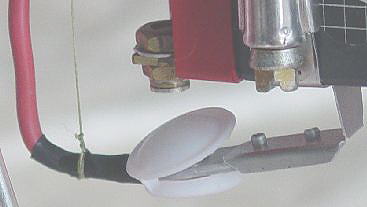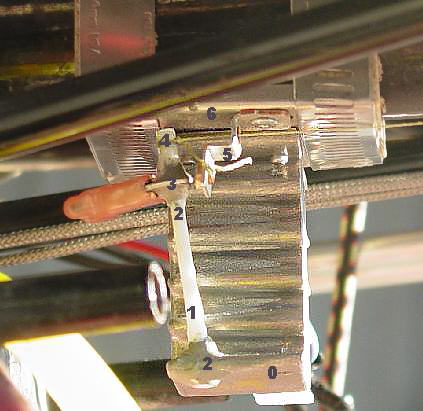|
|
 The MZ 34 starter motor requires 450 watts or 38 amperes to develop maximum torque. With the engine compression release, I thought ten guage wire would be sufficient. Contacts were taken from a salvaged compressor starter switch. One contact was soldered to a brass bolt head that holds the charge lead to the positive battery terminal. The wire coming from the starter is terminated with a similar contactor and brass bolt. Adequate spring force was found from 0.020 inch thick aluminum cut and shaped so that it could be held by the rear battery clamp. To isolate the starter contactor from ground, a piece of plastic was riveted to the spring. To activate the switch, a woven fish line is tied to the starter lead and fed up through an aluminum guide that terminates with a round fishing bobber that hangs over the pilot's right shoulder.
The MZ 34 starter motor requires 450 watts or 38 amperes to develop maximum torque. With the engine compression release, I thought ten guage wire would be sufficient. Contacts were taken from a salvaged compressor starter switch. One contact was soldered to a brass bolt head that holds the charge lead to the positive battery terminal. The wire coming from the starter is terminated with a similar contactor and brass bolt. Adequate spring force was found from 0.020 inch thick aluminum cut and shaped so that it could be held by the rear battery clamp. To isolate the starter contactor from ground, a piece of plastic was riveted to the spring. To activate the switch, a woven fish line is tied to the starter lead and fed up through an aluminum guide that terminates with a round fishing bobber that hangs over the pilot's right shoulder.
|
 With at least fifty starts, the contactors have shown no sign of pitting. There were a couple of reasons for moving the activation site from the lower left hand control panel to the right hand overhead position. This position puts the control out of reach of children. To prevent inadvertent electrical contact, a plastic pull plug from an orange juice jug opening was used. A woven fish line loop will be used as a retainer. And second, this system is at least one half lighter that what was used with the Victor 1+.
With at least fifty starts, the contactors have shown no sign of pitting. There were a couple of reasons for moving the activation site from the lower left hand control panel to the right hand overhead position. This position puts the control out of reach of children. To prevent inadvertent electrical contact, a plastic pull plug from an orange juice jug opening was used. A woven fish line loop will be used as a retainer. And second, this system is at least one half lighter that what was used with the Victor 1+.
|
 The magneto kill switch was mounted very close to the engine on alternator regulator assembly. This minimizes the amount of magneto kill wire radio interference radiation. The switch is fabricated out of relay contactors, a small diameter glass rod, JB Weld, and a pop rivet.
The magneto kill switch was mounted very close to the engine on alternator regulator assembly. This minimizes the amount of magneto kill wire radio interference radiation. The switch is fabricated out of relay contactors, a small diameter glass rod, JB Weld, and a pop rivet.
An 1/8th inch diameter hole was drilled in the lower cooling regulator cooling flange (0). A 1/8th inch diameter fiber glass rod (1) was cut to length, inserted into the hole and fixed into place with JB Weld (2). To make the hot connection, a slip wiring tab (3) was drilled and slid over the glass rod and fixed into place with JB Weld (2). To make the ground connection, a contactor was removed from a relay and pop riveted (5) to regulator mounting base plate (6). A woven fish line is tied around the glass rod at (4), threaded through a guide hole in ground contactor (5) passed on through a guide located on to of the spar cross through, and tied to a fish bobber just over the pilots left shoulder. To activate the kill switch one pulls on the bobber and bending the fiber glass rod (1) so that the tab (3) can contact the ground contact (5). To reduce the force required to make switch contact to ground, the glass rod (1) was filed or thinned so that it was easier to deflect. |